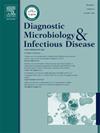The performance of nanopore sequencing in rapid detection of pathogens and antimicrobial resistance genes in blood cultures
IF 2.1
4区 医学
Q3 INFECTIOUS DISEASES
Diagnostic microbiology and infectious disease
Pub Date : 2025-01-30
DOI:10.1016/j.diagmicrobio.2025.116720
引用次数: 0
Abstract
Rapid identification of causative microbes and their resistance is essential for effective monitoring, treating, and controlling of infectious diseases. Oxford Nanopore Technologies (ONT) is capable of generating and analyzing data in real time, its potential in clinically detecting pathogens and antimicrobial resistance (AMR) genes and subsequently predicting resistance phenotypes needs to be evaluated. In this study, positive blood cultures from 67 patients with bloodstream infection were collected for matrix-assisted laser desorption ionization–time of flight mass spectrometry (MALDI-TOF-MS), ONT next generation sequencing (NGS) with a sequencing time limit of 1 h, and Illumina NGS. Antimicrobial susceptibility test was also performed. ONT NGS achieved 100 % coincidence rate (67/67) with MALDI-TOF-MS and Illumina NGS in pathogen identification, the sensitivity reached 100 %. Both ONT and Illumina NGS detected a high number of AMR genes (584 and 585, respectively). The consistent rate of ONT NGS against Illumina NGS for AMR genes detection reached 91.79 % (537/585). When considering antimicrobial susceptibility test results as the standard to evaluate the prediction value of ONT NGS in detecting AMR genes, ONT NGS showed competitive sensitivity (77.4 % vs 77.3 %), specificity (83.3 % vs 83.7 %), and accuracy (80.4 % vs 80.4 %) with Illumina NGS. Furthermore, the average time cost of ONT NGS (3.5 h) was significantly shorter than Illumina NGS (50.5 h) and MALDI-TOF-MS + antimicrobial susceptibility test (66-96 h). These findings highlight the potential of ONT NGS in rapidly and accurately detecting pathogens and AMR genes in clinical practices, which can assist in predicting resistance phenotypes and subsequently improving the diagnosis and treatment of infectious diseases.
求助全文
约1分钟内获得全文
求助全文
来源期刊
CiteScore
5.30
自引率
3.40%
发文量
149
审稿时长
56 days
期刊介绍:
Diagnostic Microbiology and Infectious Disease keeps you informed of the latest developments in clinical microbiology and the diagnosis and treatment of infectious diseases. Packed with rigorously peer-reviewed articles and studies in bacteriology, immunology, immunoserology, infectious diseases, mycology, parasitology, and virology, the journal examines new procedures, unusual cases, controversial issues, and important new literature. Diagnostic Microbiology and Infectious Disease distinguished independent editorial board, consisting of experts from many medical specialties, ensures you extensive and authoritative coverage.

 求助内容:
求助内容: 应助结果提醒方式:
应助结果提醒方式:


